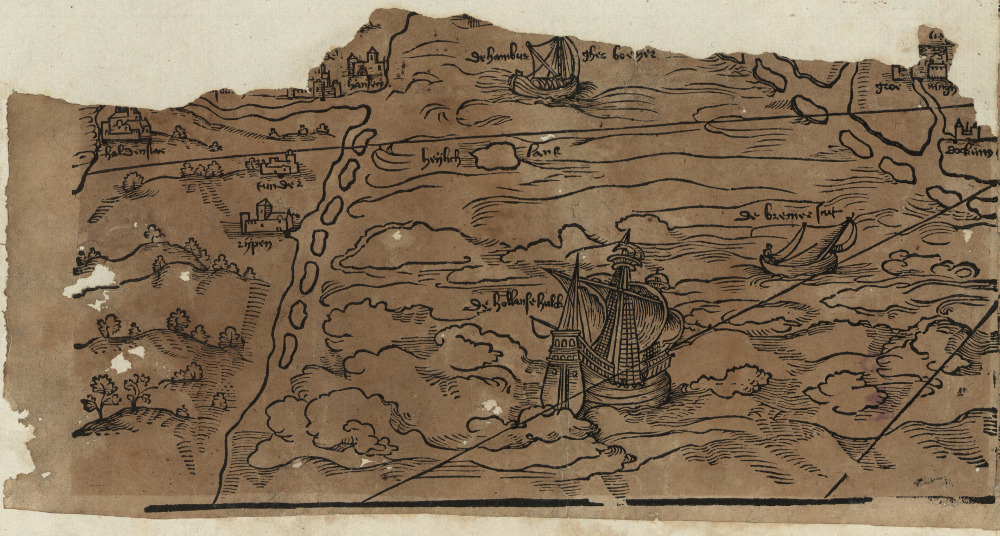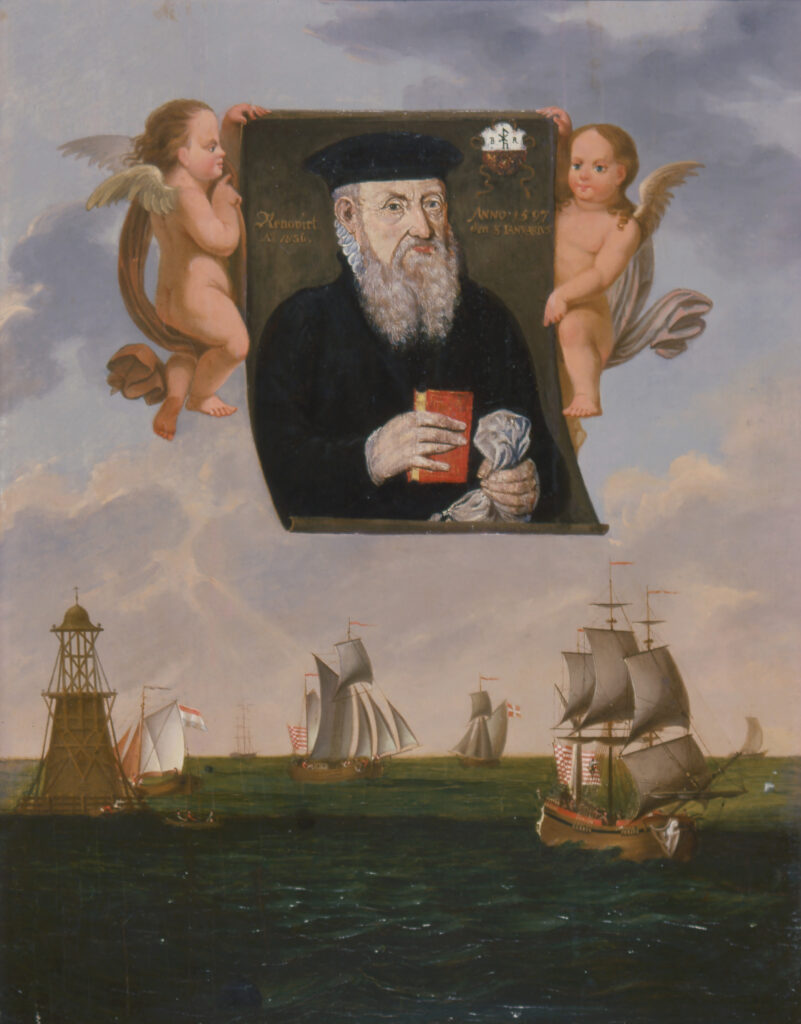Immer Weiter – Fragen und Antworten, Teil 2
Bart Holterman, 23 May 2023
(for English see below)
Hier beantworten wir die Fragen, die Besuchenden der Ausstellung „Immer Weiter – Die Hanse im Nordatlantik“ gestellt haben. In diesem zweiten Teil geht es um die Fahrt zwischen Norddeutschland und den Inseln und das Leben an Bord.
Wie lange war man damals von Bremen nach Shetland unterwegs?
Die Dauer der Fahrt zwischen Norddeutschland und Shetland war stark vom Wetter abhängig, vor allem von der Windrichtung und -stärke. Einige Tage bis einer Woche war man jedoch sicher unterwegs. Der Bremer Schiffer Brüning Rulves beschreibt zum Beispiel in seiner Memoiren eine Reise von Bremen nach Shetland im Jahr 1551, die vier Tage im Anspruch nahm.
Wie sicher waren die Schiffe im Vergleich zu heutigen Schiffen? Gab es ein Rettungskonzept?
Obwohl die meisten seefahrenden Schiffe sehr stabil gebaut waren, war die Seefahrt sehr viel gefährlicher als heutzutage. Dabei war es nicht sosehr der Bau des Schiffes, sondern die Elemente, die die größte Gefahr darstellten. Das Risiko in einem Sturm zu geraten und Schiffbruch zu erleiden war reell. In so einem Fall gab es kein Rettungskonzept, und konnte man nur hoffen, es zu überleben.
Haben sich die Leute an Bord mal geprügelt?
Das Zusammenleben vieler Leute auf engstem Raum während eines langen Zeitraums führte selbstverständlich zu Spannungen und nicht selten auch zu Prügeleien. Unter anderem aus diesem Grund herrschte an Bord eine strikte Hierarchie, wobei der Kapitän die oberste Befehlsgewalt hatte. Laut dem hansischen Seerecht war es ihm erlaubt, seine Besatzungsmitglieder (einmal) zu schlagen. Trotzdem liefen solche Situationen manchmal aus dem Ruder, wie zum Beispiel bei dem Tod des Bremer Schiffers Cordt Hemeling in Shetland im August 1557.
Was hat man damals an Bord von Schiffen gegessen und getrunken?
Auf längeren Reisen konnten natürlich keine leicht verderbliche Nahrungsmittel mitgenommen werden. Deswegen hat man vor allem getrocknete oder gesalzene Lebensmittel gegessen, wie Schiffszwieback und gesalzenes Fleisch. Auch Stockfisch und getrocknete Erbsen und Bohnen werden regelmäßig in Proviantlisten erwähnt. Getrunken hat man dabei hauptsächlich Bier. In Rechnungen für Seereisen wird regelmäßig einen Unterschied zwischen Schiffsbier gemacht: Bier das man an Bord getrunken hat bzw. das als Handelsware dienende Bier.

English version
Here we answer the questions which were asked by visitors of our exhibition „Immer Weiter – Looking In From The Edge“. This second part bundles the questions about the journey between Northern Germany and the islands and life on board.
How long did it take to travel from Bremen to Shetland in those days?
The duration of a ship’s journey depended for a large degree on the weather conditions, especially the wind direction and speed. A couple of days until a week was a likely duration for the journey from Northern Germany to Shetland. For example, the skipper Brüning Rulves from Bremen mentions in his memoirs a journey from Bremen to Shetland in 1551 which lasted four days.
How secure were historical ships in comparison to modern ships? Was there a rescue plan?
Although most seagoing ships had quite sturdy constructions, seafaring in the late Middle Ages and the early modern period was much more dangerous than nowadays. It was not so much the construction of the ship, but the elements which were dangerous. There was a high risk of getting caught up in a storm and to suffer shipwreck. In those cases there were no rescue concepts; one could only hope to survive it.
Did the people on board fight now and then?
The cohabitation of many people in a cramped space during a large period of time of course led to tensions, and not rarely to violence. Among others for this reason, a tight hierarchy prevailed on board, with the highest authority in the hands of the captain. According to Hanseatic maritime law, he was allowed to hit the others on board (once) as a disciplinary measure. However, this didn’t prevent the violence getting out of hand sometimes, such as in the case about the death of Bremen skipper Cordt Hemeling in Shetland in August 1557.
What did they eat and drink on the ships back in the day?
Perishable foodstuffs of course could not be taken on long journeys. For this reason the people on board mostly lived on dried and salted food, such as ship biscuits and salted meat. Dried peas and beans and stockfish are other examples of food which are regularly listed as provision on ship journeys. It was mainly washed down with beer. Accounts for fitting out merchant ships regularly make the distinction between ship beer and merchant beer, of which the former was drunk on board, whereas the latter served as merchandise.
Posted in: Exhibition, General
Brüning Rulves
Bart Holterman, 9 February 2023
In the collection of the Focke-Museum in Bremen, there exists a portrait of a stern-looking old bearded man, clothed in black, with in his hands a small red booklet and a handkerchief. The portrait is dated 1597, and surrounded by angels and a seascape with ships flying Dutch, Danish and Bremen flags, which is probably a later addition. The portrait is believed to represent Brüning Rulves, a retired skipper from Bremen who became famous for his memoirs, which give a rare detailed insight into the career of a 16th-century seafarer.

Regrettably, the booklet in which he kept his memoirs has been lost since the Second World War, but at least the portrait probably shows what it looked like, as the red booklet in Rulves’ hand could very well be the said memoirs. Moreover, there exists a summary and partial transcription of the book in an article from Johann Focke, the leader of the museum, from 1916. Focke translated the cited passages from the original Low German text into modern High German in his article. However, the original transcripts that Focke made from the book in order to compile his article have been preserved in the museum archives, so not all is lost.
From what Focke wrote about the book, we know that Rulves started his career at sea at the age of twelve, when he was first employed on a ship by his stepfather. At the age of 33, he had acquired enough experience as a sailor and helmsman to work as a skipper on his own ship and he continued to sail as a skipper until he retired at the age of 55. His many voyages took him all across northern Europe, from Portugal to Bergen in Norway and the Baltic Sea. After his retirement he became one of the first inhabitants of the Haus Seefahrt, a social security organisation for skippers and their families founded in 1545, which exists to this day.
The Haus Seefahrt had strong connections with the North Atlantic trade of the city of Bremen. In the foundation document it is mentioned that the merchants sailing to the “fish lands” Bergen, Iceland and Shetland used to make donations to the church after their safe return home to Bremen, but had stopped doing that since the Reformation. Now these funds were to be put to good use to care for their poor colleagues. Moreover, one of the eight founding members and elderman in 1563, Herman Wedeman, was active as a merchant in Iceland himself.
But Brüning Rulves himself was no stranger in the North as well. He sailed many times to Bergen and once, in 1551, to Shetland, after another ship had been shipwrecked. Curiously, his memoirs mention the said journey twice, on different pages, in slightly different wordings:
p. 46
“Ao. 1551. do vorfrachtede Johan Baller Hynrich van Mynden (als Johan Reyners was bleven up harfest ao. 50; was Johan Baller schip, dar se mede in Hytlant plach tho segelen, bleff ock myt man und all. Godt sy der sele gnedych) legen? van de Weser van Blexsen up eyn mandach, des donnerdages quamen wy gudt tydt in Hytlant in den Brusunt.”
p. 73
“Ao. 1551. do frachtede Johan Baller schipper Hynrich van Mynden up Hytlant, lach in Borchwage (als Johan Baller schipp was dat forige harvest ao. 1550 bleven myt soltfyske, wolde syn in Englant und Johan Reyners was dar sethschipper up, blif myt man und alles) und ick Brunynck Rulves was do myt segelt in Hytlant ao. 1551.”
Although the statements differ in small details, the general meaning is similar: Johan Ballers had freighted the ship of Johan Reyners in 1550, who was supposed to sail to Shetland to buy fish and sell them in England, but wrecked in Autumn and all on board drowned. The next year, Ballers freighted the ship of Hynrich van Mynden to sail to Shetland, and Brüning Rulves sailed with him.
Johan Ballers already appears in Shetland in a document about the sale of land in Shetland from 1539, which mentions that one of the reasons for the sale of the land was that Thomas Hacket, the owner of the land, had inherited from his late brother Robert, who had taken up credit from Ballers. A document from 1562 also refers to trade of Bremen merchants in the harbour Baltasound in Shetland “in Johan Baller’s time”. Apparently, Ballers had first traded in Shetland as a skipper himself, but by the middle of the 16th century he remained at home, providing his capital as a freighter in the trade with Shetland.
Brüning Rulves’ portrait is part of the exhibition “Immer Weiter – die Hanse im Nordatlantik”, which will be shown in the German Maritime Museum from 23 March 2023.
Further reading
Focke, Johann. ‘Das Seefahrtenbuch des Brüning Rulves’. Bremisches Jahrbuch 26 (1916): 91–144. https://brema.suub.uni-bremen.de/periodical/pageview/35267
Relevant documents in HANSdoc: https://hansdoc.dsm.museum/Hansdoc.php?varPerson=48&varSearch=people2